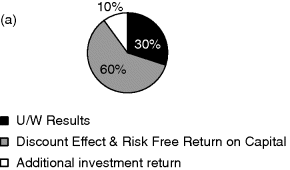Chapter 16The Economics of Asset/Liability Management
Retail and commercial banks as well as insurers take most of their financial market risk in the asset/liability portfolio.
Banks and PC insurers typically “ride the yield curve,” investing in assets with a longer duration than liabilities, in order to benefit from an upward-sloping yield curve but running the risk that the yield curve falls or flattens. In addition, PC insurers may also invest in real assets such as equities or real estate in an effort to increase earnings.
LH insurers often have the opposite rate exposure, with liabilities that have longer duration than assets available in the market, a structural mismatch exacerbated by complex embedded options and guarantees which cannot be completely hedged. In addition, LH insurers may have an incentive to invest in riskier assets when they participate in the returns from general account assets.
The Role of ALM Earnings
Financial market returns contribute significantly to the operating profits of banks and insurers.
PC Insurers
It is not unusual for investment returns to comprise anything from 70% to 100% of the total operating earnings of a PC insurance company, depending on market yields and underwriting results. Figure 16.1 illustrates the contribution to operating earnings by source for a stylized PC insurance company.1

Figure 16.1 (a) 95% Combined ratio (b) 100% ...
Get Value and Capital Management: A Handbook for the Finance and Risk Functions of Financial Institutions now with the O’Reilly learning platform.
O’Reilly members experience books, live events, courses curated by job role, and more from O’Reilly and nearly 200 top publishers.

